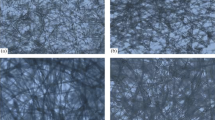Abstract
It was established using the EPR method that a magnetic field (B=0.6 T) does not affect the process of the appearance of free radicals that are formed as a result of the breaking of covalent chemical bonds in macromolecules of mechanically loaded fibers of polycaproamide. On this basis, as well as on the basis of some other data, doubts were cast on the possibility of using the assumption (frequently discussed in the literature) on the influence of a magnetic field on the rate of transformation of defect complexes due to singlet-triplet transitions upon the fluctuational lengthening of covalent bonds in such complexes for explaining some manifestations of the magnetoplastic effect in ionic crystals.
Similar content being viewed by others
References
V. I. Al’shits, E. V. Darinskaya, T. M. Perekalina, and A. A. Urusovskaya, Fiz. Tverd. Tela (Leningrad) 29(2), 467 (1987) [Sov. Phys. Solid State 29, 265 (1987)].
V. I. Al’shits, E. V. Darinskaya, and E. A. Petrzhik, Fiz. Tverd. Tela (Leningrad) 33(10), 3001 (1991) [Sov. Phys. Solid State 33, 1694 (1991)].
Yu. I. Golovin and R. B. Morgunov, Izv. Ross. Akad. Nauk, Ser. Khim., No. 4, 739 (1997).
A. A. Urusovskaya, V. I. Al’shits, A. E. Smirnov, and N. N. Bekkauér, Pis’ma Zh. Éksp. Teor. Fiz. 65(6), 470 (1997) [JETP Lett. 65, 497 (1997)].
Yu. I. Golovin and R. B. Morgunov, Fiz. Tverd. Tela (St. Petersburg) 37(7), 2118 (1995) [Phys. Solid State 37, 1152 (1995)].
Yu. I. Golovin, R. B. Morgunov, S. V. Zhulikov, and A. M. Karyakin, Izv. Ross. Akad. Nauk, Ser. Fiz. 60(9), 173 (1996).
Yu. I. Golovin, R. B. Morgunov, and S. V. Zhulikov, Fiz. Tverd. Tela (St. Petersburg) 39(3), 495 (1997) [Phys. Solid State 39, 430 (1997)].
Yu. I. Golovin, R. B. Morgunov, D. V. Lopatin, and A. A. Baskakov, Phys. Status Solidi A 160(2), R3 (1997).
Yu. I. Golovin and R. B. Morgunov, Materialovedenie, No. 3, 2 (2000); No. 4, 2 (2000); No. 5, 2 (2000); No. 6, 2 (2000).
Yu. I. Golovin and R. B. Morgunov, Zh. Éksp. Teor. Fiz. 115(2), 605 (1999) [JETP 88, 332 (1999)].
Yu. I. Golovin and R. B. Morgunov, Izv. Ross. Akad. Nauk, Ser. Fiz. 61(5), 850 (1997).
Yu. I. Golovin, R. B. Morgunov, V. E. Ivanov, and A. A. Dmitrievskii, Zh. Éksp. Teor. Fiz. 117(6), 1080 (2000) [JETP 90, 939 (2000)].
R. B. Morgunov, Author’s Abstract of Doctoral Dissertation (Voronezh. Gos. Tekhn. Univ., Voronezh, 2000).
S. N. Zhurkov, A. Ya. Savostin, and É. E. Tomashevskii, Dokl. Akad. Nauk SSSR 159(2), 303 (1964) [Sov. Phys. Dokl. 9, 986 (1965)].
B. Ya. Levin, A. V. Savitskii, A. Ya. Savostin, and É. E. Tomashevskii, Vysokomol. Soedin., Ser. A 13(4), 947 (1971).
V. A. Zakrevskii, V. V. Baptizmanskii, and É. E. Tomashevskii, Fiz. Tverd. Tela (Leningrad) 10(6), 1699 (1968) [Sov. Phys. Solid State 10, 1341 (1968)].
A. I. Slutsker, A. I. Mikhailin, and I. A. Slutsker, Usp. Fiz. Nauk 164(4), 357 (1994) [Phys. Usp. 37, 335 (1994)].
V. V. Boldyrev, V. A. Zakrevskii, and F. Kh. Urakaev, Izv. Akad. Nauk SSSR, Neorg. Mater. 15(12), 2154 (1979).
S. Z. Shmurak and F. D. Senchukov, Fiz. Tverd. Tela (Leningrad) 15(10), 2976 (1973) [Sov. Phys. Solid State 15, 1985 (1973)].
A. A. Kusov, M. I. Klinger, and V. A. Zakrevskii, Fiz. Tverd. Tela (Leningrad) 31(7), 67 (1989) [Sov. Phys. Solid State 31, 1136 (1989)].
A. V. Shuldiner and V. A. Zakrevskii, Radiat. Prot. Dosim. 65(1–4), 113 (1996).
V. A. Zakrevskii and A. V. Shul’diner, Fiz. Tverd. Tela (St. Petersburg) 42(2), 263 (2000) [Phys. Solid State 42, 270 (2000)].
C. Hoentzsch and J. M. Spaeth, Phys. Status Solidi B 88(2), 581 (1978).
Yu. I. Golovin and R. B. Morgunov, Pis’ma Zh. Éksp. Teor. Fiz. 61(7), 583 (1995) [JETP Lett. 61, 596 (1995)].
Yu. I. Golovin and R. B. Morgunov, Fiz. Tverd. Tela (St. Petersburg) 35(9), 2582 (1993) [Phys. Solid State 35, 1280 (1993)].
Author information
Authors and Affiliations
Additional information
__________
Translated from Fizika Tverdogo Tela, Vol. 44, No. 11, 2002, pp. 1990–1993.
Original Russian Text Copyright © 2002 by Zakrevskii, Pakhotin, Shul’diner.
Rights and permissions
About this article
Cite this article
Zakrevskii, V.A., Pakhotin, V.A. & Shul’diner, A.V. On the possible effect of a magnetic field on the breaking of mechanically loaded covalent chemical bonds. Phys. Solid State 44, 2083–2086 (2002). https://doi.org/10.1134/1.1521460
Received:
Accepted:
Issue Date:
DOI: https://doi.org/10.1134/1.1521460




